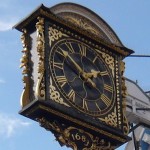- Stay Connected
 Abraham Lincoln
If given the truth, the people can be depended upon to meet any national crisis...
Abraham Lincoln
If given the truth, the people can be depended upon to meet any national crisis...
 Guildford news...
for Guildford people, brought to you by Guildford reporters - Guildford's own news service
Guildford news...
for Guildford people, brought to you by Guildford reporters - Guildford's own news service
Exclusive: New Age of Winding the Guildhall Clock
Published on: 10 Mar, 2012
Updated on: 29 May, 2012
It’s the symbol of Guildford – the Guildhall clock projecting over the High Street. But few know exactly how this ancient time piece works, or that modern technology is now being used in a bid to keep it ticking ’24/7′.
Stories have been circulating over the past few weeks that the old clock is not keeping time and that it’s something to do with it now being ‘automated’.
We have been given special access to the roof space in the Guildhall to have a look at the inner workings of the clock – some parts of which may date back some 400 years – and to see the clever autowind system that has been added to the mechanism by Guildford Borough Council.
The gilded case that overhangs the High Street does not contain the clock mechanism, that is inside the Guildhall. A rod connects the mechanism to the dials.
The mechanism, a series of interlocking cogwheels, has for centuries been connected to two pulleys on to which were wound steel cables attached to a large weights in a shaft as high as the building. Gravity pulling down on these weights provided the power for the clock. The weights had to be raised back up three times a week by manual winding.
There are, in fact, many such clock mechanisms in churches and public buildings. Today, the modern way to wind these clocks is not by hand, but to use an electric system called an autowind. The weights are wound back up by an electric motor and because it can do it much more frequently a long length of weight cable and the shaft is no longer required. There are now two sets of weights and shorter cables housed above the clock mechanism.
Guildford Borough Council’s heritage manager, economic development, Jill Draper, said: “Adding an autowind system to the clock will also help preserve the mechanism as it puts less strain on it.”
For many years the clock has been serviced and cared for by bespoke clock makers Smith of Derby (http://www.smithofderby.com/heritage/) – a firm who have been in business for 150 years, but who in recent years has added an increasing number of automated systems to the clocks it services. To date, the firm has installed some 5,000 autowind systems to its clients’ clocks in the UK and overseas.
The clock mechanism in the Guildhall is old (although beautifully made – some original blacksmith hammer marks are still discernible) a few problems with time-keeping have been occurring for years – perhaps you have noticed? After all, it is not an electronic clock of the digital age and, even so, there are far less reliable clocks in Guildford.
Nick Booth of Guildford Museum has been keeping an eye on the clock mechanism since the autowind system was installed and has been working with technicians from Smith of Derby to iron out a few teething problems.
He said: “It is likely that originally the clock only had an hour hand. Minutes and seconds were not so important years ago. It is not uncommon therefore for it to run a little fast.”

- Nick Booth has been keeping an eye on the clock making fine adjustments as the autowind system settles down. After three years, Nick is leaving Guildford Museum. I wish him well and thank him for all his help with this article and numerous other items of local history of which I have been researching.
Even when it was wound by hand, the clock, on occasions, had to be re-set. With the start and end of British Summertime, the clock is regularly stopped for an hour and the time then re-adjusted.
Nick added: “We have had to allow a period of time for the autowind system to settle down. Smith of Derby, with their special knowledge of this clock, have been very helpful.
“They are now even developing an ‘app’ (small computer application) so that you will be able to record the sound of your clock on a smart phone, send them the data and they will advise whether the clock is running fast or slow!”
Modern technology has also been playing its part when Nick has been adjusting the clock mechanism inside the roof of the Guildhall. He communicates on his mobile phone with another member of staff down in the High Street who is looking at where the hands of the clock are pointing to. In years gone by, a removable panel of wood enabled the clock winder to peer out from the roof space to check what the hands were doing.
It would appear that this grand old clock is anxious to keep pace with time. So much so that it wants to run a little fast. Nick said that the fact that it does run fast does make it easier to check. The clock can then be temporarily stopped to allow the correct time to catch up.
So, when you are checking your digital battery-powered watch against the Guildhall clock, bear in mind that if it is a few minutes out, it’s down to its long history. It’s lasted a lot, lot longer than the timepiece on your wrist ever will, and, with the care is it getting, will continue to do so.




















Recent Comments